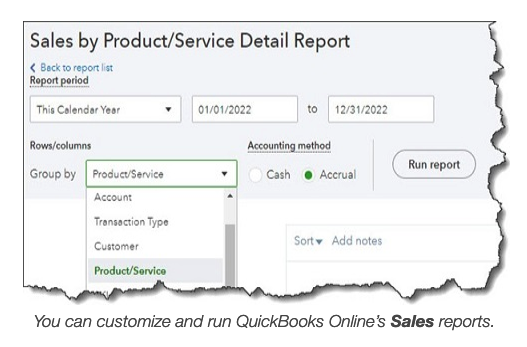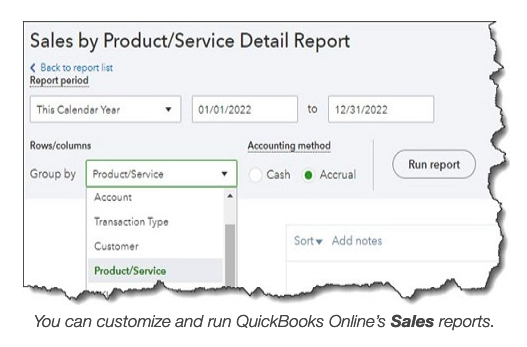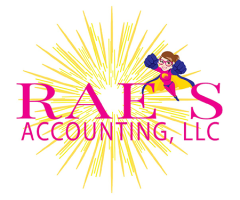Top Stories
More From Our Blogs

5 QuickBooks Online Tasks You Should Do Before January 1
On top of all of this, you should be closing out your books for the current year (as much as you can) in preparation for the new one. If you’ve been using QuickBooks Online conscientiously all year, your job will be a lot easier. But you’ll still need to carve out some time for year-end tasks.
We don’t expect that you’ll necessarily be able to wrap absolutely everything up by New Year’s Eve. You may be waiting for your customers and employees to do their part. But here are five things you can do amidst all of your other personal and professional plans that will help you get a jump on January.
Analyze your 2022 sales.

Warning: If you’re not clear about whether you should run reports in Cash or Accrual mode, let us help you with this. The distinction is important.
Know What You Owe
If money is tight at the end of the year, this will be a challenge. But you don’t want to come back from the holidays to a lot of past-due notices. To see what still needs to be paid, click Reports again and scroll down to What you owe. If you want the straight scoop right away, run Unpaid Bills. For a more detailed look, create the Accounts payable aging detail report. This groups your outstanding payables by days past due.
Know Who Still Owes You Money
This is a question that’s probably on your mind all year, but it’s especially important as the year winds down. It may be difficult to get delinquent customers to pay up in December, but you should at least know where you stand with them. Click the Reports tab again and scroll down Who owes you. Generate two reports there: Accounts receivable aging detail and Open Invoices.
You might also want to spend an hour coming up with some strategies that would encourage customers to pay faster. If you’re at a loss about this, we could sit down together and come up with a plan.
Create statements for past-due customers
Customer statements are something like reports. They display sales transactions within a given period. Statements can serve two purposes. Sometimes, customers just want a list of their invoices and payments for their records. You can also use statements as a reminder to customers who are past due on their accounts. Click New in the upper left corner, and then click Statement under Other. There are three types, but you’d be most likely to create and send two of them:
- Open Item. Displays all open, unpaid invoices for the last 365 days.
- Transaction Statement. Lists all transactions for the selected date range.

Clean up your customers and vendor lists
If you only have a few of each, your list is probably current. But if you’ve been adding customers or vendors for years without ever editing the list, you’re probably spending too much time scrolling. You don’t have to delete them. You can just make them inactive. Click Sales in the toolbar, then Customers. If you know a customer has no open activity and you want to hide them, click in the box in front of the company or customer's name. Repeat this for as many as you want, then click Batch actions in the upper left, then Make inactive.
A Busy Month
Don’t worry if you don’t get to all of these by the end of the year. But do add them to your January task list if you don’t. You might also consider having us run the standard financial reports that are available in QuickBooks Online Reports, under For my accountant. You can create reports like Trial Balance yourself, but they can be hard to analyze accurately. We’d be happy to set up a time after the first of the year to go over these after all of your 2022 transactions are in.
Gifts with Tax Benefits
A Gift of College Tuition – An interesting quirk in the gift tax laws is that an individual can pay a student’s higher-education tuitiondirectly to a qualified school, college, or university, and it will be exempt from gift tax and gift tax reporting. What student wouldn’t love to have part of their tuition paid? It would make a great gift. However, the giver isn’t allowed a charitable deduction on their income tax return for the tuition they generously paid.
As an aside, college tuition generally qualifies for a federal income tax credit. Another quirk in the tax laws says that the education credit goes to the individual who claims the child (student) as a dependent, generally resulting in a gift to the child’s parents in the form of the tax credit.
Example: Whitney is attending college and is the dependent of her mother and father. Whitney’s grandfather makes a tuition payment directly to the college; since it was made directly to the school, Whitney’s grandfather does not have any gift tax issues. Since Whitney is a dependent of her parents, her parents would claim any available tuition credit. Thus, by paying the tuition, Grandpa made a gift of tuition to his granddaughter and a gift of the tuition credit to her parents.
Qualified Tuition Program (Sec. 529 plans) – These arrangements allow taxpayers to put away large amounts of money, limited only by the projected cost of a college education, which varies from state to state with some plans capped at more than $525,000. The account’s earnings are tax-free if used to pay tuition and certain other college expenses, so the sooner the account is funded, the more it can earn. There are no limits on the number of donors or on age or income. The contributions are subject to the gift tax if the annual contribution exceeds the annual gift tax exclusion amount ($16,000 for 2022; $17,000 for 2023).
As of 2018, tax-free distributions of up to $10,000 per year per designated beneficiary are allowed for tuition (no other expenses are allowed) in connection with enrollment or attendance at elementary or secondary schools, including public, private and religious schools. However, this option should be considered cautiously, asSec. 529 plans work best when the money put into the plan is allowed to grow for a long period of time.
Qualified Charitable Distribution (QCDs) – Individuals age70½ or over can transfer up to $100,000 annually from their IRAs to qualified charities without the distribution being taxable. So, you might want to consider using QCDs for your smaller contributions. Contact your IRA custodian or trustee to arrange the transfer, which needs to be completed by December 31, 2022, to count for 2022. Since December 31, 2022 falls on a Saturday and is New Year’s Eve, it’s best not to wait until the last minute to initiate the transfer.
A word of caution:Congress, a couple of years ago, increased the IRA required minimum distribution (RMD) age to 72 but still allows QCDs once the taxpayer reaches age 70½, and they repealed the age restriction for making traditional IRA contributions beginning in 2020. This means a taxpayer can make traditional IRA contributions and QCDs after reaching age 70½. As a result, Congress included a provision in the tax law requiring a taxpayer who qualifies to make a QCD to reduce the QCD non-taxable portion by any traditional IRA contribution made after reaching 70½ that was deducted, even if the contribution and deduction are not in the same year. This is a complication you would want to consult this office about before making a QCD.Donor-Advised Funds (DAFs) – If you would like to make a substantial tax-deductible charitable donation this year but spread the actual distribution of funds to specific charities over a number of years, a donor-advised fund may fill that need. There are any number of reasons individuals choose DAFs, including making a substantial charitable donation in an exceptionally high-income year.
A DAF is a separate fund (account) set up within a public charity to which a donor makes a contribution. The donor then advises the sponsoring organization on how to ultimately distribute the funds from the account as charitable gifts over the course of many years. The fund isn’t required to follow the donor’s requests, but most do.
Tax law allows the sponsoring organization to be independent, community-based, religiously affiliated, or connected with a financial institution. Minimum contributions typically range from $5,000 to $25,000. The sponsoring organization manages the administration of the fund and handles the tax reporting, usually for an annual fee of 1%.
You get to take a tax deduction for your entire donation in the year you contribute the funds or assets to the DAF. In addition, the funds that are not distributed are invested and grow until eventually being disbursed to the charitable organization(s).
Work Equipment – If your spouse is self-employed and you purchase tools or electronics used in your spouse’s business, the costs of gifts qualify as a business tax deduction on the return for the year when the equipment is put into service.
Gifts to Employees –It is common practice this time of year for employers to give their employees gifts. If a gift is infrequently offered and has a fair market value so low that it is impractical and unreasonable to account for it, the gift’s value is treated as ade minimis fringe benefit. As such, it would be tax-free to the employee, and its cost would be tax deductible by the employer. However, be cautious, as any amount of cash given to an employee must be treated as taxable wages.
Monetary Gifts to Individuals – If you have a high net worth, you are no doubt aware that when you pass away, your estate may be subject to federal (and possibly a state) estate tax once the value of your estate exceeds an excludable amount. With the passage of the Tax Cuts and Jobs Act (TCJA), effective in 2018, the estate tax exclusion amount was more than doubled, from $5.49 million in 2017 to $11.18 million in 2018. It has been inflation-adjusted each year since, so the 2022 exclusion amount is $12.06 million ($12,920,000 for 2023).
However, in case you have forgotten, most of the provisions of the TCJA are temporary and expire after 2025, at which time the estate tax exclusion will revert back to the pre-TCJA level. Estimating the inflation adjustments, the 2026 exclusion amount would be reduced to approximately $6.25 million. Any amount of your estate in excess of the exclusion amount will be subject to the estate tax, which currently has a top rate of 40%. If you are married, the estate tax applies to the second spouse to pass away.
The value of gifts you make to individuals during your lifetime reduces the estate tax exclusion amount available to offset the value of your estate when you pass away. However, the estate tax exclusion is only reduced when the gifts you make during life exceed an annual amount, which is $16,000 for 2022 and $17,000 for 2023. That annual exclusion applies per individual, meaning you can give up to the exclusion amount to as many people you’d like every year, whether or not they are related to you, without reducing the estate tax exclusion. Unlike gifts to qualified charitable organizations, gifts to individuals are not tax deductible.
Of course, depending which political party is in control in Washington, D.C. after the 2022 and 2024 elections, the lifetime gift and estate tax exclusion could be reduced before 2026, or could be extended or made permanent. Congress would need to agree to lower the exclusion amount or extend the higher amount.
Even though gifting assets while living may reduce your estate’s tax liability, the decision to gift assets while still living is a personal one depending upon your particular circumstances.
Additionally, while the estate tax exclusion could decline after 2025, the IRS has said that the value of gifts made before then (when a higher lifetime gift and estate tax exclusion applied) won’t have to be adjusted for a reduced exemption.
Documentation – To claim a tax deduction for gifts to qualified charitable organizations, you must have substantiation. For cash contributions (gifts paid by cash, check, electronic funds transfer or credit card), you cannot claim a tax deduction, regardless of the amount, unless you have a bank record (canceled check, bank or credit union statement or credit card statement) showing the name of the qualified organization, the contribution date and the amount of the contribution. Areceipt (or a letter or other written communication) from the qualified organization showing the name of the organization, the date of the contribution and the amount of the contribution can be substituted for a bank record. For cash contributions of $250 or more and noncash donations, additional requirements not covered in this article apply.
With documentation requirements in mind, here are some words of caution about charitable contributions during the holiday season:
- When you are shopping at a mall and drop cash into the holiday collection kettle, you likely won’t get a receipt for your contribution, and a cash charitable contribution cannot be claimed as a tax deduction without documentation.
- The same goes for buying and giving new, unused toys to holiday toys-for-kids drives, which have become very popular. Tip: Save the purchase receipt for the toys and request verification of the contribution from the sponsoring organization. If the drop point for the toys is unmanned and it is not possible to obtain a contribution verification from the organization, the IRS will allow a deduction of up to $249, provided you document the purchase of your donation.
-
Timing – Charitable contributions are deductible in the year in which you make them. If you charge a gift to a credit card before the end of the year, it will count for 2022. This is true even if you don’t pay the credit card bill until 2023. In addition, a check will count for 2022 as long as you mail it in 2022.
If you have questions about how any of these suggestions might impact your tax situation, please give this office a call; happy holidays.


